Hastings
Explore hidden histories, historic photos, and things you never knew about Hastings from the collections and archives of Historic England.
Discover your local listed buildings and places
Introducing some of Hastings' most historic sites, included in the National Heritage List for England. Some of these captions have been summarised by AI. Click through for the official List entry. Skip this section and go to place by numbers
Chapel to the Former Convent of the Holy Child Jesus
Hastings
An intact High Victorian Gothic chapel, featuring altars and reredos by Pugin, with noteworthy marble, painted walls, and a nun's choir, listed at Grade II*.
Alexandra Park
Hastings
A late C19 municipal park laid out by the landscape designer Robert Marnock, to include the site of a former mid C19 public garden and with additional mid and late C20 areas of semi-natural...
Palace Court Including Former Arthur Green,34 White Rock
Hastings
Former hotel set over shops, built as Palace Hotel by Arthur Wells for the Spiers and Ponds Group.
Carlisle Parade Car Park including the subway, entrance r…
Hastings
The 2.2km length of two-tier promenade in Hastings from Carlisle Parade to Marine Court was constructed between 1925 and 1939, under the aegis of Sidney Herbert Little (1885-1961), who was...
Queens Arcade, Hastings
Hastings
Shopping arcade with assembly room of around 1881, by Philip Tree and Charles Val Hunter, erected by F Cruttenden. Read the official list entry to find out more.
1-12, 12A and 12B Pelham Arcade
Hastings
Semi-subterranean arcade of shops, developed by Joseph Kay (1775-1847) for Thomas Pelham, 2nd Earl of Chichester in 1823-5, the first phase of the Pelham scheme, also providing a revetment...
Old Hastings House
Hastings
Early to mid-18th century mansion with historical residents like General Murray and poet Coventry Patmore. Known for its architectural features like Tuscan columns and ornate balcony.
Congregational Church of St Leonard, Including Attached W…
Hastings
Congregational church (disused in 2008), built 1863-4 by W Habershon of the practice, Habershon, Spalding and Brock of London, under the patronage of Thomas Spalding of Ore Place Hastings.
Christ Church
Hastings
1878-81 by R H Carpenter. W tower, 1890. Read the official list entry to find out more.
Roman Catholic Church of St Mary Star of the Sea
Hastings
Roman Catholic parish church, built 1882-3 for the Pallottine Order, at the instigation of the poet, writer and thinker, Coventry Patmore and designed by Basil Champneys (1842-1935).
Hastings Castle
Hastings
Hastings Castle, built circa 1070, features ruins of the collegiate Church of St Mary and remnants of curtain walls with a gatehouse and bastions.
Iron Age cliff castle and site of St George's churchyard …
Hastings
The East Hill site features an Iron Age cliff castle, preserved for its unique bank and unusual hornwork outside south-west England, and includes St George's churchyard from 1291.
Drinking fountain immediately north-east of the Church of…
Hastings
Drinking fountain, erected in 1861 to designs by SS Teulon (1812-1873). Read the official list entry to find out more.
Church of St John the Evangelist
Hastings
The Church of St John the Evangelist, constructed between 1950-54 by H.S. Goodhart-Rendel, features a blend of Victorian Gothic style with eclectic elements, on a prominent site.
Hastings Library, the former Brassey Institute
Hastings
Public institute of arts and sciences of 1878-1880, to the designs of WL Vernon (1846-1914), for Thomas Brassey, MP, (1836-1918), now (2023) in use as Hastings Library.
Church of the Holy Trinity
Hastings
Anglican church, built between 1857 and 1862 to designs by SS Teulon (1812-1873) and extended in 1892. Read the official list entry to find out more.
Church of St Mary Magdalene
Hastings
1852 by Frederick Marrable. 1872 SW tower. Read the official list entry to find out more.
Number 1, Bank Buildings
Hastings
A bank of around 1857 for the London and County Bank, constructed by John Howell & Son of Hastings, (architect unknown), extended in the earlier C20.
Former Memorial Photographic Studios
Hastings
Photographic studios and memorial art gallery, built c1864 by Mr Plummer for photographer FR Wells, in Italianate manner. Read the official list entry to find out more.
Church of St Leonard
Hastings
Church, 1953-1961, Adrian Gilbert Scott. Read the official list entry to find out more.
21 Robertson Street
Hastings
Commercial building, built as part of a terrace between 1850 and 1859 to the designs of CF Reeks and AJ Humbert for Patrick Robertson, MP, of Hastings and provided with an Art Deco shopfront...
31 Old Penny School House, 31A and 31B
Hastings
Former National School and attached school mistress' house, later known locally as the Penny School. Dated 1855, by S S Teulon, in Gothic Revival manner.
Crown House
Hastings
Crown House, designed by James Burton in 1828, was renamed Victoria House after Princess Victoria's visit. It features a two-storey structure with a colonnade verandah.
Manor house (remains of), Ore Place
Hastings
Country houses of late Tudor and Jacobean periods show distinct architectural styles and historical significance, reflecting the Protestant elite's wealth and courtly connections...
No 2 (The Old Rectory) Including Garden Wall in Front
Hastings
Late-C18 rectory, refaced with stucco in the C19. Read the official list entry to find out more.
The Clock House
Hastings
The Clock House in St Leonards, possibly designed by Decimus Burton, is an early Gothic revival house with a distinctive tower and sandstone ashlar construction.
14 Claremont
Hastings
Former printing works and newspaper office, built for FW Parsons (1844-1900) for the Hastings Observer Newspaper between 1876 and 1879, to the designs of WL Vernon (1846-1914), converted to...
Cast iron boundary post on Mount Pleasant
Hastings
Boundary post, probably dating from c1830. Read the official list entry to find out more.
Cast iron boundary post on Maze Hill Terrace
Hastings
Boundary post, probably dating from c1830. Read the official list entry to find out more.
Cast iron boundary post on Quarry Hill
Hastings
Boundary post, probably dating from c1830. Read the official list entry to find out more.
Cast iron boundary post on Upper Maze Hill
Hastings
Boundary post, probably dating from c1830. Read the official list entry to find out more.
Cast iron boundary post in Market Passage
Hastings
Boundary post, probably dating from c1830. Read the official list entry to find out more.
77, 77A, 79 and 79A, Bohemia Road
Hastings
A pair of c1875 end of terrace buildings comprising two shops (Nos 77 and 79) of c1900 and c1910 and living accommodation (Nos 77A and 79A) above.
31, High Street
Hastings
Wealden house, C15. Hall floor inserted late C16, upper chamber floors inserted late C16 to early C17. The southern bay divided from the main house to form No.
United Reformed Church Formerly Congregational Church
Hastings
Congregational church, 1885 by Henry Ward, in a classical Mannerist manner. Replacing an earlier smaller church of 1857 which had been enlarged in 1864.
Lift shaft and winding mechanism to the rear of 40 to 41 …
Hastings
Former carriage lift shaft and winding mechanism built around 1875 to 1899 for Rock and Sons Carriage Manufacturers. Read the official list entry to find out more.
Explore more
Search for more listed placesHastings through time
This timeline shows the first period of use for buildings and places on the National Heritage List for England, just one of the details recorded for every list entry. Click around to see how Hastings changes over time. Skip this section and go to aerial photos
Prehistoric Before AD 43
Prehistory covers a million years of human occupation before the Roman invasion and the introduction of writing. Primarily hunter-gatherers of several human species including Neanderthals, the peoples moved across Europe, hunting animals, exchanging ideas and developing complex culture and belief systems including burial rites and astronomical understanding, as at Stonehenge for example.
Medieval AD 1066 to AD 1540
This period, sometimes known as the Middle Ages, began with the Norman invasion in AD 1066. It saw a significant rise in military and defensive buildings such as castles and earthworks, as well as religious houses dominating a largely agricultural landscape.
The monarchy and Church dominated the period, which also saw the break with the Roman Catholic Church and the English reformation.
Post medieval AD 1540 to AD 1901
The Post-Medieval period brought seismic changes to life in England, with religious reformation leading to the democratization of worship and the destruction of hundreds of religious houses.
In parallel, there was a huge expansion of scientific study and enlightenment that permanently altered the nation's social structure and landscape. Industrialization and mass production lead to wider global trade, emigration, and immigration.
20th century AD 1901 to AD 2000
The 20th century saw an incredible expansion of England's transport networks, with suburban growth shadowing rapid infrastructural expansion. The establishment of state schools, hospitals, and modern technical colleges, with new architectural styles, radically changed the appearance of towns and cities.
Two catastrophic world wars and the 1918 pandemic also brought unprecedented change, altering England's built environment and social structures forever.
Prehistoric Before AD 43
Prehistory covers a million years of human occupation before the Roman invasion and the introduction of writing. Primarily hunter-gatherers of several human species including Neanderthals, the peoples moved across Europe, hunting animals, exchanging ideas and developing complex culture and belief systems including burial rites and astronomical understanding, as at Stonehenge for example.
Medieval AD 1066 to AD 1540
This period, sometimes known as the Middle Ages, began with the Norman invasion in AD 1066. It saw a significant rise in military and defensive buildings such as castles and earthworks, as well as religious houses dominating a largely agricultural landscape.
The monarchy and Church dominated the period, which also saw the break with the Roman Catholic Church and the English reformation.
Post medieval AD 1540 to AD 1901
The Post-Medieval period brought seismic changes to life in England, with religious reformation leading to the democratization of worship and the destruction of hundreds of religious houses.
In parallel, there was a huge expansion of scientific study and enlightenment that permanently altered the nation's social structure and landscape. Industrialization and mass production lead to wider global trade, emigration, and immigration.
20th century AD 1901 to AD 2000
The 20th century saw an incredible expansion of England's transport networks, with suburban growth shadowing rapid infrastructural expansion. The establishment of state schools, hospitals, and modern technical colleges, with new architectural styles, radically changed the appearance of towns and cities.
Two catastrophic world wars and the 1918 pandemic also brought unprecedented change, altering England's built environment and social structures forever.
Aerial photos of Hastings
Aerial photography helps reveal secrets of England's changing landscapes that are impossible to see from the ground. Skip this section and go to archive images

Hastings
Carlisle Parade and environs, Hastings, 1926

Hastings
The entrance to the Carlisle Parade underground car park alongside Robertson Terrace and the seafront, Hastings, 1932

Hastings
Pelham Crescent and Castle Hill, Hastings, 1920
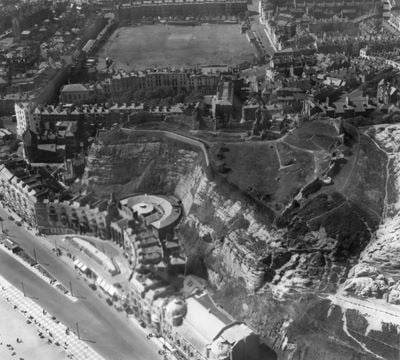
Hastings
Church of St Mary in the Castle, Hastings Castle and environs, Hastings, 1947
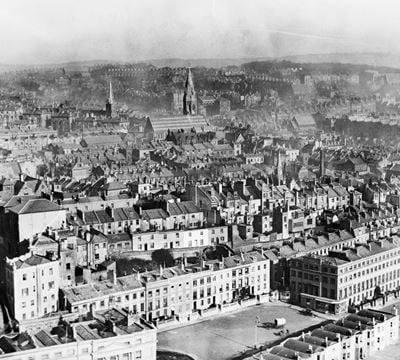
Hastings
General View, Hastings, 1920
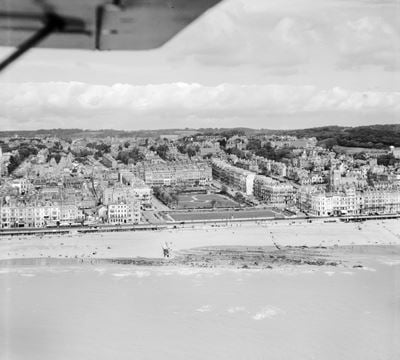
Hastings
The seafront and town centred upon Warrior Square, Hastings, 1946
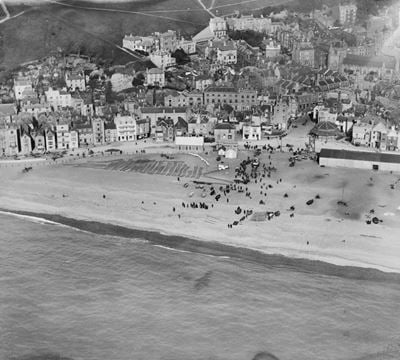
Hastings
East Parade, Hastings, 1920
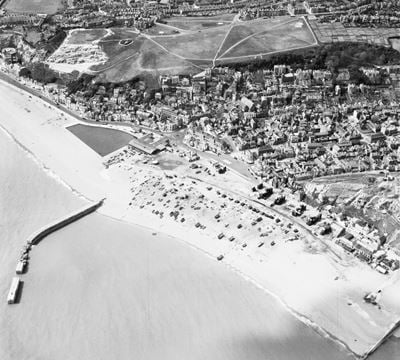
Hastings
Old Town and the harbour, Hastings, 1949
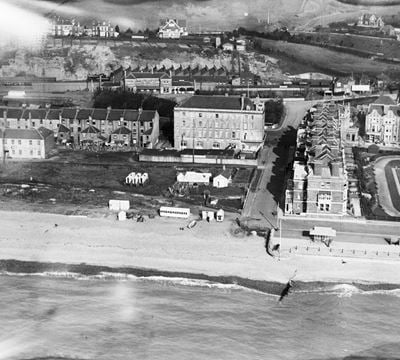
St Leonards
West Marina and Station, St Leonards, Hastings, 1920

St Leonards
St Leonards Lido, Hastings, 1962
Hastings in the Historic England Archive
The Historic England Archive cares for over 15 million images, dating from the 1850s to the present day. Discover stunning images of Hastings' past. Skip this section and go to stories about heritage
Eric de Mare
St Leonards On Sea, Hastings, Hastings, East Sussex
Date created: 1945 - 1980
Exterior view looking along the porch of the Church of the Holy Ghost at St Leonards on Sea.
John Laing Collection
Hastings, East Sussex
Date created: 1949
A detail showing the assembly of steel shuttering for the construction of Easiform housing in Hastings
Nigel Temple Collection of Postcards of Parks and Gardens
St Leonards On Sea, Hastings, Hastings, East Sussex
Date created: 01 Jan 1906 - 11 Apr 1911
GENERAL VIEW LOOKING ACROSS LAKE TOWARDS THATCHED GARDEN BUILDING
Eric de Mare
St Leonards On Sea, Hastings, Hastings, East Sussex
Date created: 1945 - 1980
Exterior view of the Church of the Holy Ghost in St Leonards on Sea showing the steps and porch.
John Laing Collection
Hastings, East Sussex
Date created: 01 Jul 1949
Men digging foundations for an Easiform housing development in Hastings
Nigel Temple Collection of Postcards of Parks and Gardens
St Leonards On Sea, Hastings, Hastings, East Sussex
Date created: 1902 - 1907
GENERAL VIEW ACROSS THE LAKE
Eric de Mare
St Leonards On Sea, Hastings, Hastings, East Sussex
Date created: 1945 - 1980
General view of the Church of the Holy Ghost in St Leonards on Sea showing the porch and door.
John Laing Collection
Hastings, East Sussex
Date created: 01 Jul 1949
A worker placing framework for a doorway into metal shuttering during the construction of Easiform housing in Hastings
Nigel Temple Collection of Postcards of Parks and Gardens
St Leonards On Sea, Hastings, Hastings, East Sussex
Date created: 1901 - 1906
GENERAL VIEW SHOWING LAKE
Eric de Mare
Hastings, East Sussex
Date created: 1956
General view in Hastings showing a group of fishermen's stores.
John Laing Collection
Hastings, East Sussex
Date created: 01 Jul 1949
Close-up of a worker checking the level of shuttering during the construction of Easiform housing in Hastings
Nigel Temple Collection of Postcards of Parks and Gardens
St Leonards On Sea, Hastings, Hastings, East Sussex
Date created: 1900 - 1920
GENERAL VIEW ACROSS THE LAKE
Stories about heritage in your local area
Historic England publishes news, blogs, research, videos, and podcasts celebrating England's rich heritage. Discover the stories we have about Hastings. Skip this section and go to education
What Is the Oldest Castle in England?
Mentions Hastings Castle
Discover the oldest English castle contenders, including the Norman Berkhamsted Castle, Windsor Castle, Dover Castle and The White Tower, London.
Historic North Sea Floods
Mentions Hastings Castle, the Collegiate Church of St Mary and the Ladies' Parlour
The 1953 East Coast floods and other major historic floods that have impacted coastal England over the last 1,000 years.
Mentions Hastings
In Borrowed Ground, writer Robin Pridy has combined Hastings’ familiar sites, sounds and smells with the stories and memories of local people, to turn...
Hastings | Borrowed Ground | story by Robin Pridy
In Borrowed Ground, writer Robin Pridy has combined Hastings’ familiar sites, sounds and smells with the stories and memories of local people, to turn the town’s Trinity Triangle into the backdrop for the fascinating life of her character, Jackie Brigham. You can download the ebook of all the stories at https://historicengland.org.uk/highstreettales Made in conjunction with New Writing North and New Writing South, and the series was produced by Sonderbug Productions with thanks to Darren Hayman for use of his song Pram Town. High Street Tales is part of Historic England’s High Street Cultural Programme; four years of nationwide cultural activity helping to make high streets more attractive, engaging and vibrant places for people to live, work and spend time. The programme is run by Historic England, in partnership with Heritage Lottery Fund and Arts Council England. Follow us on social @HistoricEngland, using the hashtag #HighStreetTales.
Mentions Hastings
Picturing High Streets was a 3-year partnership between Historic England and photography champions @photoworks_uk, who worked with 9 regional partner...
How Photography Captured England’s Changing High Streets
Picturing High Streets was a 3-year partnership between Historic England and photography champions @photoworks_uk, who worked with 9 regional partner photography organisations to create a contemporary picture of England’s high streets.
Mentions Hastings
Brothers Rich and Marc Moore rescued a derelict Victorian swimming pool and turned it into a state-of-the-art facility for BMX riders and skaters...
Restoring Source Park in Hastings
Brothers Rich and Marc Moore rescued a derelict Victorian swimming pool and turned it into a state-of-the-art facility for BMX riders and skaters worldwide.
Research Reports Roundup February 2025
Mentions Hastings
A roundup of the latest additions to our research reports database from October 2024 to February 2025, arranged by theme.
Researching High Street Heritage Action Zones
Mentions Hastings
Research by Historic England is adding value to the regeneration of historic high streets.
Managing Lithic Sites
Mentions Hastings
New advice addresses research and management issues for sites where prehistoric stone tools contain unique evidence.
The Serious Business of Holidaymaking
Mentions Hastings
A look at the history of tourism and tourist destinations in Britain.
I Do Like to See Beside the Seaside
Mentions Hastings
Exploring 150 years of seaside photography in the Historic England Archive.
Picturing High Streets: Over 200 Images Taken by the Public Enter Historic England Archive
Mentions Hastings
Documenting a year in the life of the English high street, images taken by the public as part of 'Picturing High Streets' can be viewed online.
Enriching the List, Enriching Lives
Mentions Hastings
Research into how Historic England's Enriching the List initiative can help the personal wellbeing of contributors.
High Streets Heritage Action Zones’ Cultural Programme Launches with 'High Street Tales'
Mentions Hastings
Today Historic England launches a podcast and ebook called 'High Street Tales'. These are the first events of a four-year-long cultural programme.
Groundbreaking Women of Science Celebrated
Mentions Hastings
Historic England and The Royal Society celebrate International Women’s Day by bringing to light the exceptional achievements of female scientists
Hastings' social history through photos
Over 10,000 images from the Historic England Archive have been specially selected and re-captioned for teachers, students, and anyone who wants to learn more about their local area. Skip this section and go to grant-aided places
The Town Hall, Hastings, East Sussex
Period: Victorian (1837 - 1901)
Hastings Town Hall was built in 1880. It was made in an Early English style, making clever use of an awkward triangular site.
The Town Hall, Hastings, East Sussex
The Beach, Hastings, East Sussex
Period: Victorian (1837 - 1901)
Hastings beach and promenade crowded with tourists. Sailing boats appear to be taking people on trips.
The Beach, Hastings, East Sussex
Robertson Street, Hastings, East Sussex
Period: Victorian (1837 - 1901)
Carte de visite showing a view looking north-east along Robertson Street, with two men standing in the road in the foreground.
Robertson Street, Hastings, East Sussex
Queen Victoria Memorial Statue, Warrior Square, Hastings, East Sussex
Period: Edwardian (1902 - 1913)
The memorial of Queen Victoria was built by the sculptor F. J. Williamson. Queen Victoria had died a year before the statue was constructed.
Queen Victoria Memorial Statue, Warrior Square, Hastings, East Sussex
Pelham Place, Hastings, East Sussex
Period: Victorian (1837 - 1901)
Postcard showing a view from the south-west looking up at the terraced houses of Pelham Place.
Pelham Place, Hastings, East Sussex
Palace Hotel, The Parade, Hastings, East Sussex
Period: Victorian (1837 - 1901)
A view of the Palace Hotel taken from The Parade. It shows the entrance to the Ladies' Baths.
Palace Hotel, The Parade, Hastings, East Sussex
Observer and Advertiser Offices, Hastings, East Sussex
Period: Victorian (1837 - 1901)
This building was originally built in 1878-80 for Thomas Brassey, MP. It was built in a style taken from 16th century North European sources.
Observer and Advertiser Offices, Hastings, East Sussex
Lifeboat Station, Hastings, East Sussex
Period: Victorian (1837 - 1901)
A view from the beach showing waves crashing against the lifeboat house.
Lifeboat Station, Hastings, East Sussex
Discover more
Ready for more local heritage? Take a look at these other places nearby


